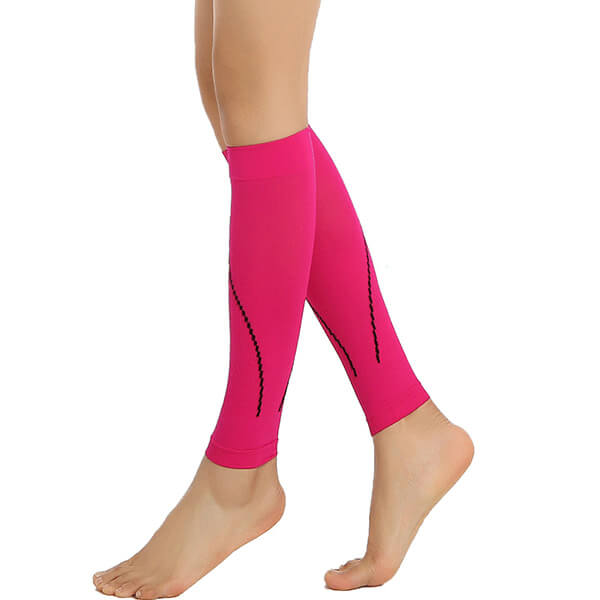Por Elizabeth Quinn
As meias de compressão já existem há algum tempo, mas só nos últimos anos é que os atletas adicionaram as meias justas até ao joelho ao seu saco de truques de desempenho e recuperação. Então, será que as meias de compressão ajudam o desempenho desportivo ou a recuperação?
O vestuário de compressão, incluindo meias, peúgas, mangas e ligaduras, foi concebido principalmente para ajudar a melhorar o fluxo sanguíneo em doentes pós-cirúrgicos, diabéticos, pessoas com problemas circulatórios ou indivíduos propensos a inchaço (edema) e flebite, veias varicosase trombose venosa profunda (TVP).
Para estes doentes inactivos e acamados, as ligaduras apertadas para as pernas ajudam o sangue a regressar ao coração para que não se acumule nas extremidades inferiores e cause inchaço. A compressão também reduz e risco de coágulos sanguíneos.
Os atletas começaram a utilizar meias de compressão na esperança de obterem benefícios semelhantes no que respeita à melhoria do fluxo sanguíneo. No início, um pequeno grupo de corredores usava as meias apertadas após os treinos e depois durante as corridas de resistência mais longas. Os relatos anedóticos de recuperações mais rápidas, melhor desempenho na corrida e diminuição da dor durante a utilização de meias de compressão começaram a aumentar e, com isso, surgiu uma longa lista de potenciais benefícios das meias de compressão.
Desempenho
Acreditava-se que o uso das meias durante o exercício ajudaria o desempenho, aumentaria o fornecimento de oxigénio e o fluxo sanguíneo, reduziria o choque, a vibração e o stress para os músculos e evitaria danos nos tecidos moles, tais como dores nas canelas.
Alguns atletas sentiram que a compressão adicional à volta dos gémeos e tornozelos também ajudou propriocepção e até melhorar o equilíbrio. Esperava-se também que a melhoria do fluxo sanguíneo venoso e a compressão dos músculos da barriga da perna resultassem num aumento da resistência, num disparo muscular mais eficiente e em tempos de corrida mais rápidos.
Algumas dessas teorias, mas não todas, foram comprovadas pela investigação. A maior parte dos estudos ainda não encontrou diferenças estatisticamente significativas no desempenho durante o uso das meias de compressão. Alguns estudos registaram melhorias nos tempos de corrida durante eventos de ultra-resistência em alguns atletas, mas a maior parte da investigação não encontrou benefícios dramáticos na utilização de meias de compressão para melhorar desempenho desportivo, tempos de corrida ou resistência. Até à data, os benefícios da utilização de meias de compressão durante o exercício não são claros, mas alguns atletas estão convencidos de que funciona para eles.
Recuperação
Quando se trata de usar meias de compressão para a recuperação desportiva, a investigação pinta um quadro ligeiramente diferente: um número crescente de estudos sugere que a utilização de meias de compressão pode, de facto, recuperação de velocidade e reduzir a dor após um treino extenuante. Os resultados variam, mas a tendência aponta para uma diminuição das dores musculares e possivelmente menos danos musculares e uma recuperação mais rápida quando se utilizam meias de compressão após o exercício. Alguns estudos também apoiam a teoria de que o uso de meias de compressão durante corridas de resistência intensas, pliometria ou treino de sprinttambém pode reduzir a quantidade de dor pós-exercício relatada pelos atletas.
Não se esqueça de que medir com precisão a dor é uma tarefa complicada e que classificar o nível de dor que o atleta sente após o treino é subjetivo e difícil de quantificar. Há também a questão muito real efeito placebo que alguns atletas podem sentir quando usam vestuário de compressão. O impulso psicológico e a crença de que o vestuário pode melhorar a recuperação, juntamente com a sensação de compressão, podem ter um efeito maior na perceção de dor de um atleta. E, como qualquer atleta sabe, aquilo em que acreditamos pode ter um impacto muito real no nosso desempenho.
Assim, embora as meias de compressão possam não ser a solução mágica para melhorar o desempenho e a recuperação mais rápida de todos os atletas em todas as situações, podem oferecer outra boa ajuda à recuperação para alguns atletas nas circunstâncias certas.
As recomendações actuais de especialistas e atletas parecem sugerir que os atletas podem encontrar um ligeiro aumento da eficiência mecânica quando usam meias de compressão em eventos de resistência longos e difíceis. O mais provável é que a utilização de meias de compressão possa ser mais uma ferramenta para ajudar na recuperação durante o período de 24 horas que se segue a um treino intenso ou a uma competição.
Obter o ajuste correto
Para obter os benefícios das meias de compressão, é essencial a quantidade correta de compressão. Devem ser mais apertadas no tornozelo e diminuir gradualmente a compressão até ao joelho. Por isso, não se esqueça de seguir as instruções de ajuste do fabricante antes de comprar vestuário de compressão. A compressão ideal ainda está a ser descoberta, mas os estudos actuais indicam que uma compressão de cerca de 15-25 mmHg de pressão é ideal, desde que seja graduada (um pouco mais de pressão no tornozelo e menos à medida que se sobe na perna). Demasiada compressão pode diminuir o fluxo sanguíneo e muito pouca compressão oferece poucos benefícios, pelo que o truque é fazer a compressão correta.
Ao comprar meias de compressão, é necessário medir a circunferência da barriga da perna e do tornozelo, e não o tamanho do sapato. A maioria das marcas no mercado oferece um ajuste semelhante, mas siga as instruções do fabricante e utilize o tamanho recomendado para a sua medida da barriga da perna para obter a pressão de compressão adequada.
Ainda não tem a certeza se são um verdadeiro auxiliar de treino ou apenas mais uma moda? A melhor maneira de descobrir se as meias funcionam é provavelmente experimentá-las e ver o que acha. Podem não ser para toda a gente, mas certamente não prejudicarão a sua recuperação.









